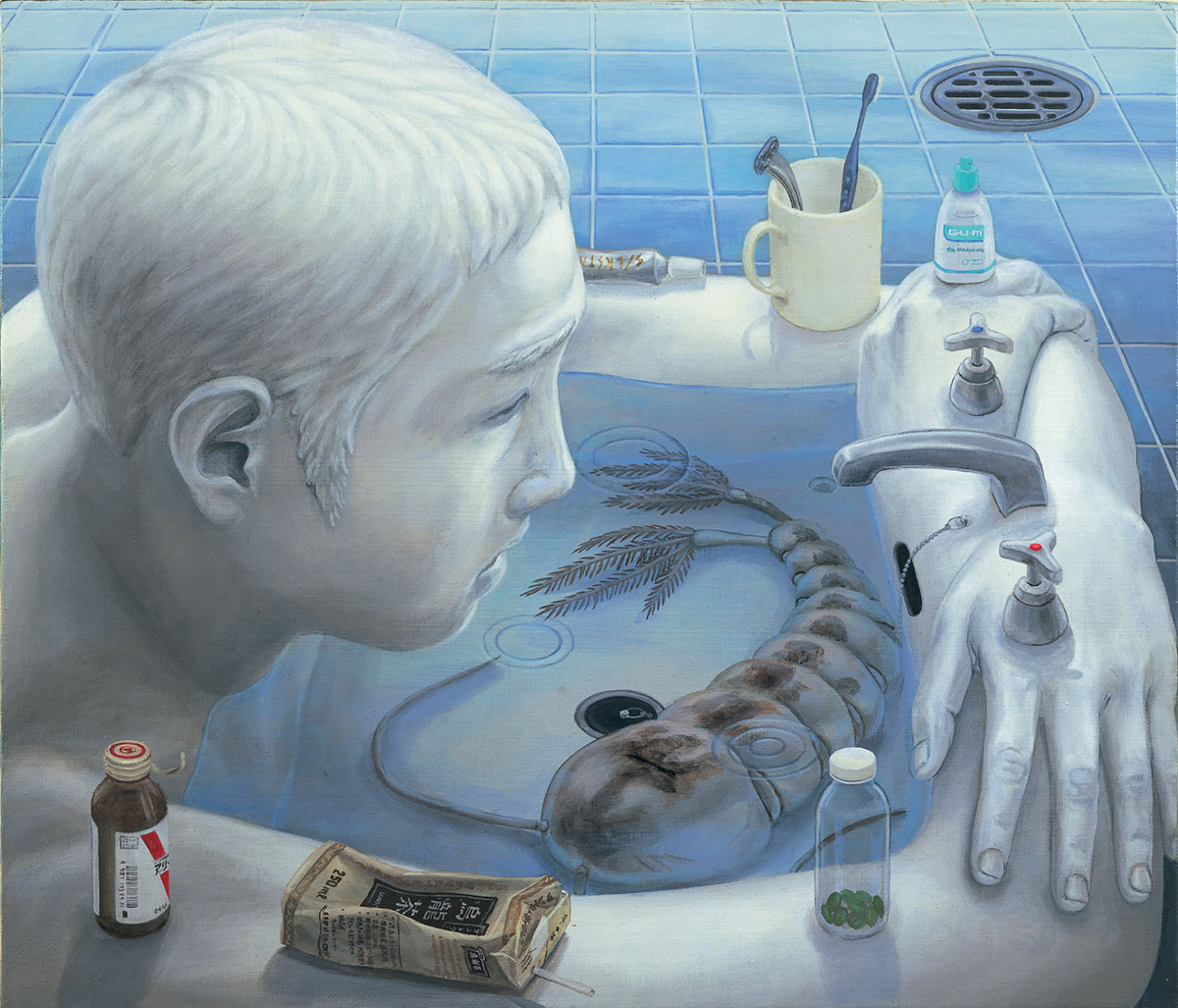ART CITIES: N.York-Tetsuya Ishida
 Tetsuya Ishida came of age as a painter during Japan’s “lost decade”, a time of nationwide economic recession that lasted through the 1990s. In his afflictive paintings, he captured the feelings of hopelessness, claustrophobia, and emotional isolation that burdened him and dominated Japanese society. From his early career until his untimely death in 2005, Ishida provided vivid allegories of the challenges to Japanese life and morale in paintings and graphic works charged with dark Orwellian absurdity.
Tetsuya Ishida came of age as a painter during Japan’s “lost decade”, a time of nationwide economic recession that lasted through the 1990s. In his afflictive paintings, he captured the feelings of hopelessness, claustrophobia, and emotional isolation that burdened him and dominated Japanese society. From his early career until his untimely death in 2005, Ishida provided vivid allegories of the challenges to Japanese life and morale in paintings and graphic works charged with dark Orwellian absurdity.
By Dimitris Lempesis
Photo: Gagosian Archive
“My Anxious Self” is the most comprehensive exhibition of Tetsuya Ishida’s work to have been staged outside of Japan, and his first ever in New York. With works from 1996, the year he finished his degree in fine art at Musashino University, Tokyo, to 2004, shortly before his sudden death. His paintings, drawings, and notebooks are a testimony to the malaise and alienation of contemporary subjects in advanced capitalism. A cult artist in his own country, where his imaginary world has become a reference for younger generations, his sharply critical work was presented in Europe at the 56 Venice Biennale in 2015. Ishida’s skeptical, nihilistic realism bears witness to today’s normalization of precarity and consumption in every sphere of life. The characters in his works are hybrid, anthropomorphic machines who embody a state of total technological domination and limitless subordination to a new, inescapable form of slavery that makes no distinction between work and consumption and heightens the anxiety of our bodies and subjectivities. Ishida’s bitter social satire cuts away at the Japanese postwar financial miracle, stripping it of any idealistic consideration. Although the 1973 petrol crisis briefly affected scientific, industrial, and technological growth in Japan, the country’s developmental trend was boosted in the 1980s at the height of real estate speculation, which led to the bursting in 1991 of the financial bubble and the deep depression that followed. This was a gloomy period of wholesale economic restructuring fed by the need to adapt and reinvent: factories intensified large-scale robotic automation, industrial methods were used to rationalize the workforce, the service sector took over from manufacturing, and unemployment rates rose to previously unseen levels. Ishida was one of the so-called lost generation of those years, the skeptical product of truncated lives and unmet expectations that resulted from the crisis. Ishida plays with the scales between things, buildings, and people and dislocates spatial relationships in his compositions, accentuating the viewer’s disquiet at the lack of emotion and other signifiers of communal memory in his work. His body-machines, objectified and bound, exist in solitary confrontation with the disorientation of depersonalized urban spaces, or question their adolescent identities or childhood, which opens up as a sort of black hole into a disturbing regression that still carries some innocence. Ishida died at the age of thirty-one after he was struck by a train at a level crossing in Machida, Tokyo.
Ishida produced a total of 217 paintings during his lifetime, many of which were not discovered until years later. Often depicting identical-looking students and white-collar “salarymen” fused with machines, buildings, and consumer products, they convey a sense of foreboding and desperation emphasized by a subdued palette of blues and grays. The unsettling disfigurements endured by his subjects allegorize the pressures placed on Japanese citizens by their country’s changing identity, and by the myriad challenges of integrating new technologies into existing social and professional structures. “My Anxious Self” is divided into five thematic parts, each of which occupies a separate room in Gagosian gallery. “Waiting for a Chance” explores ideas of estrangement and the loss of self through images of assembly lines and regimented worker-consumers. Many of the paintings in this grouping also depict people fused with or partially transformed into machines: “Interview” (1998), for example, reimagines a trio of interviewers as enormous microscopes preparing to examine a hapless candidate. Another section, “Helpless Metamorphoses” features works portraying human bodies comingled with animals or objects, strongly recalling the oneiric themes of Surrealism but augmenting that movement’s rangy probing of the unconscious psyche with a social critique specific to Ishida’s millennial time and place. “Desperately Lonely” focuses on scenes of solitude and isolation set in built interiors that are often also being invaded by nature or merging in other ways with the outside world. In “Plant-Eating Dragon” (2004), for example, a curled-up man surrounded by drug paraphernalia wraps himself in a blanket that takes the form of a grassy field dotted with trees and crisscrossed by dirt paths. Another section, “Neo-Tokyo” concentrates on cityscapes and urban exteriors, additionally featuring source materials for Ishida’s work such as movies, news broadcasts, and the artist’s favorite manga and anime. Finally, “Restless Dream” comprises paintings dominated by haunting images of maternity and childhood, dreams and death. In “Characters” (2003), a naked figure (as ever, it could be the artist’s own) lies on a white bed surrounded by falling leaves. Within his body, four progressively smaller and paler versions are nested, matryoshka style, the smallest one sitting up as if ready to take its leave.
Photo: Tetsuya Ishida, Untitled, 2004, Acrylic and oil on canvas, 17 7/8 × 20 7/8 inches (45.4 × 53 cm), © Tetsuya Ishida Estate, Courtesy the artist and Gagosian
Info: Curator: Cecilia Alemani, Gagosian Gallery, 555 West 24th Street, New York, NY, USA, Duration: 12/9-21/10/2023, Days & Hours: Tue-Sat 10:00-18:00, https://gagosian.com/

Right: Tetsuya Ishida, Gripe, 1996, Acrylic on board, 23 3/8 × 16 5/8 inches (59.4 × 42 cm), © Tetsuya Ishida Estate, Photo: Martin Wong, Courtesy Gagosian





